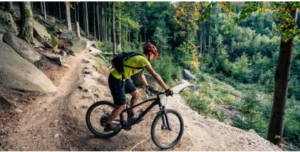Buying a Mountain Bike
Mountain biking can be an exhilarating sport, yet it does present some inherent risks. A miscalculation, environmental hazards and rider limitations all pose potential hazards that could cause accidents.
For safety purposes, mountain bikers must always carry a first aid kit and fuel up with high-carb meals before embarking on their ride. One of the top safety tips for mountain biking riders is fuelling up with carbs!
Choosing a Bike
 Modern mountain bikes are incredible mountain bike components designed to give riders confidence and enjoyment on various terrain. But with so many bikes and parts at different price points, selecting the ideal bike may prove challenging.
Modern mountain bikes are incredible mountain bike components designed to give riders confidence and enjoyment on various terrain. But with so many bikes and parts at different price points, selecting the ideal bike may prove challenging.
First and foremost, when purchasing an MTB, you must decide the riding you plan to do with it. Although no definitive answer exists here, more knowledge about your goals will help narrow your options more effectively.
Once you know the terrain you will be riding on, other mountain bike components must be considered. For instance, if your riding consists of many climbing and shuttle laps, a lightweight mountain bike with a 1x drivetrain (no chainrings up front) would likely be more suitable; otherwise, a suspension system that provides greater control and rider comfort may be essential.
Finding the correct frame size is also significant. A bike that’s too small may become unwieldy during technical descents and uncomfortable on longer rides; conversely, one that’s too big will feel sluggish on tight switchbacks. To determine your ideal fit, speak to an experienced salesperson at your local bike shop for guidance on sizing matters.
Frame Size
Selecting the ideal frame size when buying a mountain bike is one of the most critical decisions you’ll face when shopping for one. Manufacturer’s size charts offer an initial starting point; for best results, visit your local bike shop to take measurements (inseam length, torso size and arm length) as well as test ride various models before making your choice.
Professional bike fitters utilise sophisticated measurement tools to determine the ideal frame size for you and assess your riding style, flexibility and any injuries or restrictions they might detect.
Mountain bikes stand apart from road bikes through their unique frame geometry, which helps them perform so effectively on rugged terrain. Frames can be constructed from various materials – the most popular being aluminium and steel due to their high strength-to-weight ratio; other possibilities include titanium which offers similar durability while remaining significantly lighter in weight.
Reach is defined as the distance from the bottom bracket to the head tube centre and is vital in dictating how far riders can extend their legs while straddling the seat. A longer reach enables a more comfortable position for riders with long legs compared to their torso length, while shorter reaches may be better suited to limited mobility or those favouring agile and responsive handling.
Frame Material
Buying a mountain bike requires making many important choices about frame materials. Each material provides distinct properties and benefits while having some drawbacks – aluminium is often preferred among entry-level bikes, while carbon fibre offers increased stiffness that improves power transfer for easier climbing on rough trails.
Suspension
Suspension on mountain bikes, commonly called front shocks or forks, allows the wheels to rise and fall when taking on bumps or landing jumps, providing a more comfortable ride. This mountain bike components feature can absorb shocks while attenuating any discomfort felt through bumpy trails; especially beneficial for beginners and experienced riders pushing hard on technical trail sections. Suspensions are commonly found on most mountain bikes and can be adjusted using spring and damper tuning techniques.
All suspension systems have two essential parts: the spring and the damper. The spring, commonly called a “shock absorber, ” controls shock resistance by adjusting air pressure levels accordingly and can be tuned by adjusting resistance settings on shocks.
Damping adjustments are what truly differentiates one fork or shock from another. There are two primary types of damping: compression and rebound. Low-speed compression is typically used during everyday events like pedalling and braking and can be tuned to either make it feel firmer or softer; high-speed compression, on the other hand, is typically reserved for impacts where its speed may need to change quickly – these settings are known as tuning; you can make these settings to match your riding style and trail conditions perfectly.